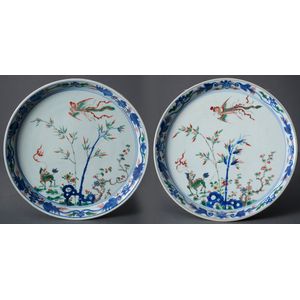Large Wucai Dishes with Phoenix and Qilin Motifs
A pair of large Chinese Wucai dishes Qing Dynasty (1644-1912), Kangxi period decorated with phoenix and Qilin in a landscape in wucai enamels to the front, and with crane amongst clouds in sancai enamels to the base. 4 cm high, 30.5 cm diameter. Provenance: Mossgreen Auctions, 24 November 2008, lot 479 Ex ray Tregaskis, Sydney Sotheby's London, 21 July 1979, lot 204. Literature: Published in J. Ayers ceramics - the Kroger collection, London, 1985, no. 110
You must be a subscriber, and be logged in to view price and dealer details.
Subscribe Now to view actual auction price for this item
When you subscribe, you have the option of setting the currency in which to display prices to $Au, $US, $NZ or Stg.
This item has been sold, and the description, image and price are for reference purposes only.
- Qing Dynasty - The Qing Dynasty was the last imperial dynasty of China, ruling from 1644 to 1912. It was established by the Manchu people, who originated from the northeastern region of China. The Qing Dynasty was preceded by the Ming Dynasty and followed by the Republic of China.
- Kylin or Qilin - A kylin or qilin is a mythical Chinese animal, dating back to the 5th century with the head of a dragon, the body of a deer and the tail of a lion. It is a regarded as a good omen bringing serenity and prosperity, and is said to appear with the coming or departure of a wise sage or illustrious ruler.
It is also part of the culture of Korea and Japan.
As well as being represented in bronze and jade, it is also used as a decorative motif on ceramics. - Ming Dynasty - The Ming Dynasty was a ruling dynasty of China from 1368 to 1644. It succeeded the Yuan Dynasty and preceded the Qing Dynasty. The Ming Dynasty was established by Zhu Yuanzhang, a former Buddhist monk who became a rebel leader and eventually overthrew the Mongol Yuan Dynasty. During the Ming Dynasty, China experienced a period of relative stability and prosperity. The government was centralized and bureaucratic, with the emperor at the top of the hierarchy. The Ming Dynasty is known for its cultural achievements, including the development of porcelain, the invention of movable type printing, and the construction of the Great Wall of China.
This item has been included into following indexes:
- Chinese ceramics, dynasty mark or period
- Chinese ceramics, famille - bowls and dishes, famille verte 109
- Chinese ceramics, famille decoration - famille verte, Wucai, other 283
- Chinese ceramics, item type - vases, Sancai glaze 67
